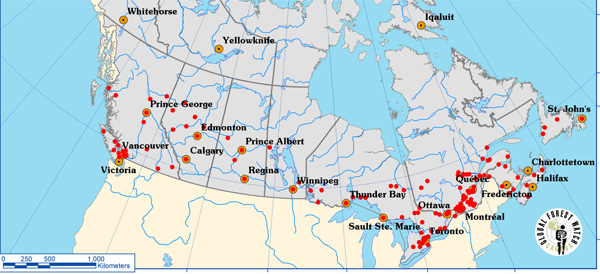Things Looking up for Canada’s Forest and Forest Products Sector
![]() Print this Article | Send to Colleague
Print this Article | Send to Colleague
According to an article published by iPolitics, Ontario, Canada, Canadian forest products exports are up 10% this year. Forest products are Canada’s number one export to Asia, and the industry makes up 12% of Canada’s manufacturing GDP.
These positive facts cast a different light than recent stories suggesting that the Canadian forest industry is virtually dying — especially the pulp and paper sector. It certainly is true that the industry was devastated during the recent recession and that the pulp and paper sector was especially hard hit by the rise of electronic media.

However, things are now looking up as the industry has transformed and found its footing once again. For example, industry employment numbers have been stable since 2010, and in the period 2010-2012, the industry hired 8,000 employees. Half of this was a result of retiring workers — the other half was the result of new hires. On any given day, about 500 jobs are open in the forest products sector.
The industry has also estimated, based on figures from a Conference Board study for the Forest Products Sector Council, which forest companies will need to recruit 60,000 new employees by the end of the decade.
Exports are going up. In fact, exports to China have increased 275% over the past decade. Canada is the world’s second-largest forest product exporter. And the forest products industry has the second largest trade balance of any industry in Canada next to oil and gas.
Wood fiber is now being used in car parts, clothing, chemicals, cosmetics, and more.
There is also cautious optimism about the future. The focus is on innovation as the engine of growth and maximizing value from wood fiber. Canada has been a global leader in the research and development of innovations from wood, including cellulose nano-crystals. Wood fiber is now being used in car parts, clothing, chemicals, cosmetics, and more. As a bonus, many of these products, sourced from a renewable resource, will be replacing products made from more carbon-intensive materials.
The development of engineered wood products such as cross-laminated timber is allowing the construction of higher wood-frame buildings. Ontario recently followed the example of British Columbia by permitting six-story wood frame buildings, up from the current four story limit, and the National Building Code is expected to follow suit next year.
Many public forest companies also have seen increases in their stock value in the past year. The economic situation also could further improve because the lower value of the Canadian dollar could boost exports.
These kinds of developments have given the industry enough confidence to set the goal of generating an additional $20 billion in new products and markets by the end of the decade.
There are no doubts that many challenges remain in the Canadian forest products sector. However, this is not a sunset industry — the sun is rising on a new forward-looking value-added forest industry that will continue to create jobs and prosperity in Canada.


